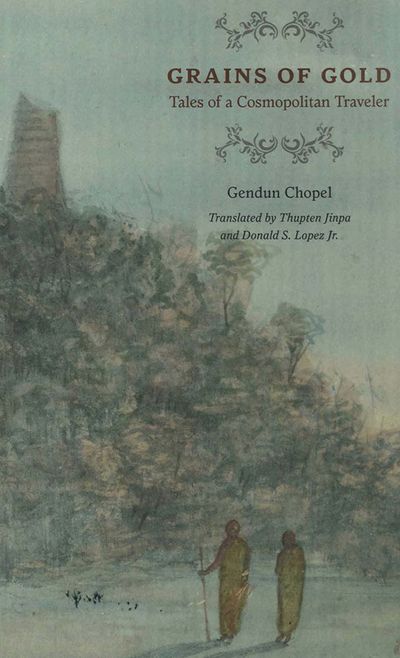|
|
| (4 intermediate revisions by 3 users not shown) |
| Line 1: |
Line 1: |
| {{Book | | {{Book |
| |BookParentPage=Research/Secondary Sources
| |
| |BookPerson={{Book-person | | |BookPerson={{Book-person |
| |PersonPage=Person/Chöpel, Gendün | | |PersonPage=People/Chöpel, Gendün |
| |PersonName=Gendün Chöpel | | |PersonName=Gendün Chöpel |
| }}{{Book-person | | }}{{Book-person |
| |PersonPage=Person/Jinpa, Thupten | | |PersonPage=People/Jinpa, Thupten |
| |PersonName=Thupten Jinpa | | |PersonName=Thupten Jinpa |
| }}{{Book-person | | }}{{Book-person |
| |PersonPage=Person/Lopez, D. | | |PersonPage=People/Lopez, D. |
| |PersonName=Donald S. Lopez, Jr. | | |PersonName=Donald S. Lopez, Jr. |
| }} | | }} |
| |FullTextRead=No | | |FullTextRead=No |
| |BookEssay=Thupten Jinpa and Donald S. Lopez, Jr deliver Gendun Chopel's life's work--the account of his pilgrimage through South Asia that combines travelogue, drawings, history, and ethnography--in English. Scholars and practitioners alike will embrace these tales of ancient India, recent Indian past, and early Tibetan history told from Chopel's sharp, critical humor that comes alive through Thupten Jinpa and Donald S. Lopez's rendering. An appendix including Tibetan transliterations used in the work, notes, and an index are included. | | |BookEssay=Thupten Jinpa and Donald S. Lopez, Jr deliver Gendun Chopel's life's work--the account of his pilgrimage through South Asia that combines travelogue, drawings, history, and ethnography--in English. Scholars and practitioners alike will embrace these tales of ancient India, recent Indian past, and early Tibetan history told from Chopel's sharp, critical humor that comes alive through Thupten Jinpa and Donald S. Lopez's rendering. An appendix including Tibetan transliterations used in the work, notes, and an index are included. |
| |BookToc=*{{Introduction}} | | |BookToc=***Introduction<br> |
| **{{i|1 First, How I Set Out from Lhasa}} | | ***''By Thupten Jinpa and Donald Lopez Jr. 1'' |
| **{{i|2 General Formation of the Land of India and How It Acquired Its Name}}
| |
| **{{i|3 How the Lands Were Given Their Names}} | |
| **{{i|4 The Snow Mountains of the North and Analysis of Related Issues}} | |
| **{{i|5 What the Famous Places of the Past Are Like}}
| |
| **{{i|6 On Men, Women, Food, Drink, and Various Apparel}}
| |
| **{{i|7 Identification of Various Species of Flowers and Trees and How to Recognize Them}}
| |
| **{{i|8 Writing Systems of Various Regions of Past and Present}}
| |
| **{{i|9 On the Linguistic Rules of the Tibetan Language}}
| |
| **{{i|10 The Inscriptions of the Dharma King Aśoka Carved on the Rock Face of Mount Girnar}}
| |
| **{{i|11 The Gupta Dynasty}}
| |
| **{{i|12 The Pāla Dynasty}}
| |
| **{{i|13 From 1,600 Years after the Passing of the Buddha to the Present}}
| |
| **{{i|14 On the History of Siṅghala}}
| |
| **{{i|15 On the Conditions and the Customs of the Tibetan People in Ancient Times}}
| |
| **{{i|16 The Religion of the Tīrthikas}}
| |
| **{{i|17 Conclusion}}
| |
|
| |
|
| **{{i|Appendix A: Tibetan Transliteration}} | | *{{i|1 First, How I Set Out from Lhasa|29}} |
| **{{i|Appendix B: Glossary of Terms}} | | *{{i|2 General Formation of the Land of India and How It Acquired Its Name|59}} |
| **{{i|Acknowledgments}} | | *{{i|3 How the Lands Were Given Their Names|71}} |
| **{{i|Notes}} | | *{{i|4 The Snow Mountains of the North and Analysis of Related Issues|89}} |
| **{{i|Index}} | | *{{i|5 What the Famous Places of the Past Are Like|95}} |
| | *{{i|6 On Men, Women, Food, Drink, and Various Apparel|129}} |
| | *{{i|7 Identification of Various Species of Flowers and Trees and How to Recognize<br>Them|175}} |
| | *{{i|8 Writing Systems of Various Regions of Past and Present|189}} |
| | *{{i|9 On the Linguistic Rules of the Tibetan Language|209}} |
| | *{{i|10 The Inscriptions of the Dharma King Aśoka Carved on the Rock Face of Mount Girnar|221}} |
| | *{{i|11 The Gupta Dynasty|229}} |
| | *{{i|12 The Pāla Dynasty|259}} |
| | *{{i|13 From 1,600 Years after the Passing of the Buddha to the Present|279}} |
| | *{{i|14 On the History of Siṅghala|305}} |
| | *{{i|15 On the Conditions and the Customs of the Tibetan People in Ancient Times|349}} |
| | *{{i|16 The Religion of the Tīrthikas|363}} |
| | *{{i|17 Conclusion|397}} |
| | |
| | ***{{i|Appendix A: Tibetan Transliteration|417}} |
| | ***{{i|Appendix B: Glossary of Terms|419}} |
| | ***{{i|Acknowledgments|425}} |
| | ***{{i|Notes|427}} |
| | ***{{i|Index|453}} |
| | |PublisherLogo=File:University of Chicago Press-logo.png |
| | |PostStatus=Needs Copy Editing |
| | |StopPersonRedirects=No |
| |AddRelatedTab=No | | |AddRelatedTab=No |
| |PostStatus=Needs Copy Editing | | |BookParentPage=Research/Secondary Sources |
| }} | | }} |



